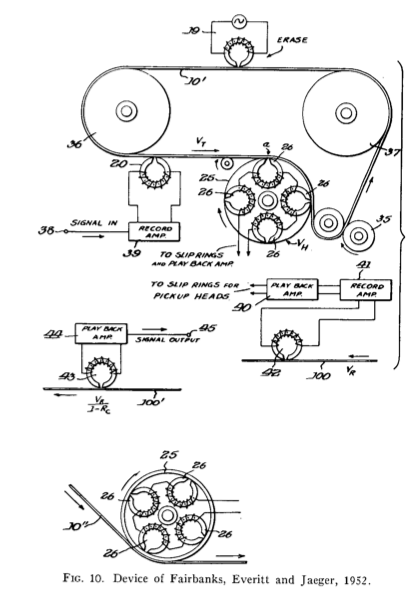Subtotal: $50 USD
Pitch Shifters, pre-digital
When I was doing research on pitch shifting for my analysis of the Eno/Lanois “shimmer” effect, I had presumed that I would start with the first commercially available digital pitch shifter, the Eventide H910 Harmonizer. However, it is worth exploring the analog pitch changing devices that predated the H910 by several decades.
In a 1966 Journal of the Audio Engineering Society article, William Marlens traces the history of analog pitch and time changing devices, with the earliest patents dating back to the 1920’s. The basic idea of all of the patents was to record the audio signal onto some moving medium (tape, wire, film, etc.), and then use a rotating playback head, where the read heads would be moving at a different rate as the recording head:
The rotary playback head has 2, 4 or more read heads. By adjusting the rate of the rotation relative to the tape motion, the pitch of the signal can be raised or lowered. Time expansion / compression can be achieved by speeding up or slowing down the rate of the tape, while keeping the tape heads moving past the tape at a rate that is identical to the original recording rate. As a given tape head comes into contact and is rotated away from the tape, the output signal from that given head will fade in and out, which results in a natural cross-fading of pitch shifted segments.
It is hard to track down audio examples of these early time/pitch changers. Stockhausen made use of one for Hymnen, and other European electronic music studios had similar devices on hand, but the most common use in the US seemed to be shortening audio for commercials to fit a given length. Strangely enough, the Beach Boys seem to have made use of a rotary head pitch shifter on a few songs. Listen to the vocals in “She’s Going Bald” off 1967’s Smiley Smile, starting at 0:51, to hear the characteristic formant shift and warbly sound of a cross-fading pitch shifter.
The Beach Boys also used a fixed rotary speed to add a metallic effect to the drums on “Do It Again.” It is most obvious on the intro:
Wendy Carlos has a detailed blog post about her experiences with the Eltro “Information Rate Changer.” Carlos describes how this 1960’s rotary tape head device was used for the voice of HAL 9000 in “2001” (Carlos wasn’t involved with 2001, but had the story relayed to her by Stanley Kubrick). Apparently the Eltro was used on HAL’s voice throughout the film, but the effect is most obvious in the “death” scene. At 3:06, you can hear the voice start to warble more, presumably as the signal’s pitch was shifted further downwards:
One of Carlos’ experiments involved recording a signal onto an Ampex tape deck, using the Eltro to play back the signal, and sending some of the pitch shifted signal to the record head of the Ampex. This resulted in a pitch shifted tape delay loop, where each repeat was higher (or lower) in pitch. This pitch shifted feedback, in digital form, is a crucial component of the Eno/Lanois shimmer effect. It seems that Wendy Carlos was exploring similar realms a few decades earlier.
 Valhalla Shimmer
Valhalla Shimmer 




Fantastic set of posts. Thanks !
Just stumbled upon your blog. It’s incredible. Keep it up!
I believe one early example of this kind of tape-based analog pitch-shifting/time-stretching device would be the Phonogene, as created under the direction of Pierre Schaeffer by the GRMC (or later, GRM) in France.
http://en.wikipedia.org/wiki/Musique_concr%C3%A8te#The_phonogene
Here’s a guy who has built his own version using modified reel-to-reel tape recorders:
http://www.joostnieuwenburg.nl/phonogene.html
IIRC, the earlier versions of the Phonogene were duration-based tape playback devices. In other words, you could play a tape at a defined pitch ratio (itself no small accomplishment), but the duration of the sound would change with the pitch. Higher pitch = faster sound.
The later Phonogene used a Springer apparatus, which was a German-made rotary head pitch transposer that was first seen in the 1950’s. My guess is that Stockhausen used a Springer for “Hymnen,” but I’m not sure about that, and it’s been a while since I listened to that album.
That homemade rotary tape apparatus is pretty incredible. The sound examples show a fair amount of pitch warble in the time-stretched signal, but the transposed sound would need to be 5.2 times higher than the original signal, which is a far larger ratio than the old devices ever attempted.
Great post! Really interesting. Would it be a gross misunderstanding to say that these early pitchshifters worked in a smillar way to granular pitchshifting?
I mean the 4 rotating tape heads are reading or ‘sampling’ grains of sound from the playback tape, right?
You are totally correct. You could view the rotary tape head apparatus as a 2-tap granulator (even though there are 4 tape heads, in practice you only heard 2 of the heads at a time, with a fairly minimal overlap between those heads), with a grain rate that varied with the shifting amount, and a fixed offset between the grain delays.
Funny how all the ideas and concepts have been in place for such a long time. All we are doing is pouring them into new forms…
Then again I have no idea how digital pitchshifters work, so maybe those are built around the same principles.
Some modern digital pitch shifters work on identical principles as described above. Others use more modern techniques. PSOLA is used in many AutoTune-type plugs, although Robert Bristow-Johnson has said that it isn’t used in AutoTune (and he knows what he is talking about here, as he did a lot of work on recent Eventide pitch shifting algorithms). Other plugins use frequency domain techniques, such as phase vocoding. I think that a well-tuned phase vocoder has a better chance of artifact free pitch shifting than the simpler overlap-add techniques used by the early stuff. However, the artifacts of the old stuff can sound really cool, and can lead to exciting new artifacts if subjected to a combination of thoughtful DSP design techniques and thoughtless abuse.
Just found your blog, its great!
@seancostello:
Stockhausen indeed used a springer machine in several of his pieces.
the phonogene that i build from scratch is in fact more a springer device than a phonogene (you have the chromatique and the à coulisse, the latter uses the springer principle). As with most of the early electronic music experiments they happend both in Paris and Cologne, (prob also in Stockholm, Belllabs, Phillipsstudios etc.) and where more diverent from eachother in methodology than in the actual technical specs. The project that I did on the topic is a conceptual lecture/performance that seeks to de-mystify and mystify in the same time. Offcourse its an instrument on its own and can be used in many other ways than just shifting pitch. (I believe one of the ideas behind the development of such a device was to shorten a radio interview without the obvious rise in pitch) I guess my own interest takes its point of departure of modernism in sound and the inner world of sound that was opened up (with all the artifacts that come with it) and the implications that is has when the frequency domain no longer has to correspond with the time domain.
All best Joost
I wonder if another use of this would be the short track ‘Big Top’ that ends King Crimson’s ‘Lizard’ album of 1970…. it’s a carnival-esque musical snippet repeated several times , rising in pitch and speed each time. (Make sure you listen to the original mix, not the 2011 remix, which does not replicate the effect).
(make that 2009 remix, not 2011)
Here’s the catalog advertising the Eltro Mark II Information Rate Changer
https://archive.org/details/TNM_Demonstration_of_compressed_and_expanded_spee_20170712_0065
and a digitized recording of the device:
https://archive.org/details/TNM_infotronic_eltro_information_rate_changer
Nice! Thanks for posting these links.
I am Stephen W. Desper, Beach Boy engineer and mixer of many years and working for the group during the time DO IT AGAIN was recorded. I created the drum effect used at the beginning and elsewhere in the song. This effect was also created by me when mixing live concerts if the song was featured. This effect was NOT created using the Eltro pitch changer. It was created using a Phillips Ambisonic tape loop machine with the four playback heads positioned to add a duplicate of the original at 10-millisecond intervals. (original, plus 10 ms delay, plus 20 ms delay. plus 30 ms delay, plus 40 ms delay — all added at equal levels). Also the pitch rate change in GOIN BALD was made using another pitch changer device, a borrowed prototype under development that did not require a separate tape recorder. During the time of the GOIN BALD recording, the Eltro had just been introduced into this country in NYC. It had yet to be available in the western states. Please remove this misinformation from your otherwise excellent article. Thanks ~